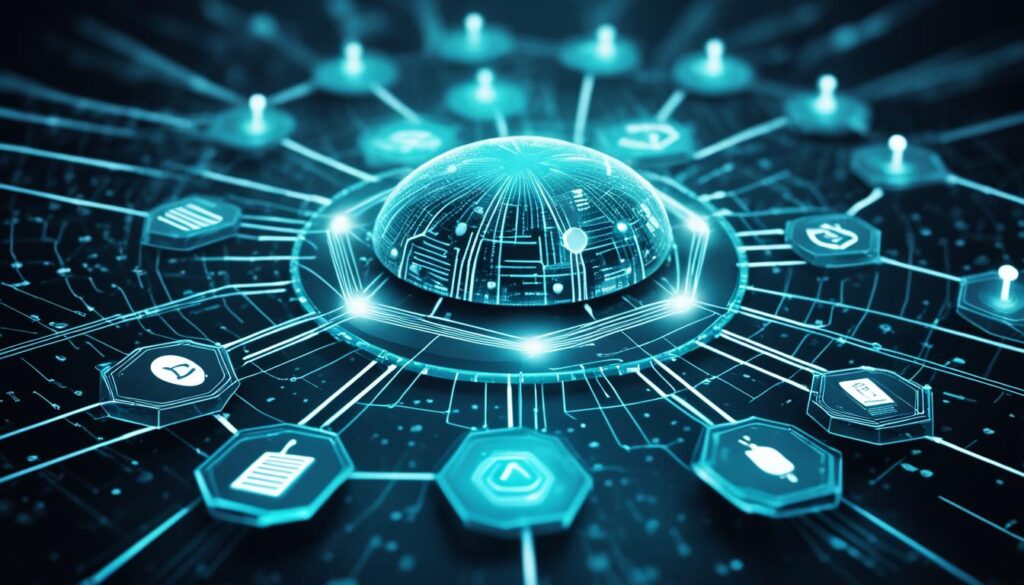In today’s digital landscape, the scale and sophistication of cyber threats continue to escalate at an alarming rate. To put it into perspective, consider this: phishing attacks, one of the most prevalent forms of cybercrime, have grown in both sophistication and frequency as a result of advancements in artificial intelligence (AI) technology1. With cybercriminals harnessing AI capabilities, even novice hackers can rapidly emerge with devastating consequences1. As AI-driven attacks become increasingly prevalent, organizations must adapt their cybersecurity strategies to effectively counter these threats.
AI is revolutionizing the field of cybersecurity, particularly in advanced threat detection. AI-powered security solutions have the ability to process vast amounts of data in real time, allowing for more accurate and proactive threat detection1. By leveraging predictive analytics and automated defenses, AI enables cybersecurity teams to predict and mitigate threats quicker than ever before1. Furthermore, AI automates responses to certain attacks, which reduces the burden on human analysts and enables them to focus on more critical tasks1.
When it comes to phishing detection, AI excels at analyzing email content and user behavior patterns to improve detection accuracy1. By continually learning from new data, AI systems can adapt to emerging threats and evolve over time, staying one step ahead of cybercriminals1. One significant example of how AI is transforming cybersecurity is demonstrated by PhishFirewall, a leading cybersecurity training and phishing prevention platform that leverages AI for personalized user education and realistic phishing simulations1.
Key Takeaways:
- Phishing attacks have grown in sophistication and frequency due to AI-driven advancements1.
- Cybercriminals are harnessing AI capabilities, enabling rapid growth of novice hackers1.
- AI-driven security tools process vast amounts of data in real time, enhancing threat detection1.
- AI enables quicker prediction and mitigation of threats, improving overall cybersecurity1.
- PhishFirewall utilizes AI for personalized cybersecurity training and realistic phishing simulations1.
The Rising Threat: AI in the Hands of Cybercriminals
Cybercriminals are increasingly leveraging AI to carry out sophisticated attacks, posing a significant threat to organizations worldwide. Through AI-driven techniques, such as AI-driven attacks and phishing attacks, cybercriminals can exploit vulnerabilities in an organization’s systems with greater precision and scale.
“The existence of sophisticated AI-driven cyberattacks, such as bots manipulating online reservations for profit, highlights the need for organizations to prepare for the evolving digital threats posed by AI.”2
AI technologies have become more accessible to cybercriminals, enabling them to analyze vulnerabilities and devise targeted attacks that can bypass traditional security measures. These AI-driven attacks exploit weaknesses in network infrastructures, applications, and even user behavior, making them harder to detect and thwart.
AI’s ability to autonomously adapt and learn makes it a powerful tool in the hands of cybercriminals. By continually evolving their attack techniques using AI algorithms, cyber adversaries can outmaneuver traditional security defenses.
Phishing attacks, one of the most prevalent cyber threats, have also evolved with the help of AI. Cybercriminals can leverage AI algorithms to customize phishing emails with more convincing and personalized content, increasing the likelihood of successful attacks.
“AI-powered email security solutions can block up to 99% of phishing attacks.”3
Furthermore, AI can automate the process of identifying potential targets for phishing attacks by analyzing vast amounts of publicly available data and social media profiles. This automation allows cybercriminals to cast a wider net and exploit unsuspecting individuals and organizations.
Vulnerabilities in software and systems also present an opportunity for cybercriminals to exploit AI. By exploiting these vulnerabilities, cyber adversaries can manipulate AI algorithms to bypass security measures and access sensitive information or disrupt critical operations.
The rising threat of AI in the hands of cybercriminals requires organizations to enhance their cybersecurity defenses and stay one step ahead. Deploying AI-driven security solutions to detect and mitigate these AI-driven attacks is essential.
“AI-powered security solutions can improve threat detection accuracy by up to 20%.”3
Combining AI with other cybersecurity measures, including proactive monitoring, incident response, and user education, can help organizations strengthen their defenses against AI-driven cyber threats.
Why AI is Essential for Cybersecurity
Artificial intelligence (AI) is an indispensable tool in the field of cybersecurity, providing organizations with advanced threat detection capabilities and proactive defense strategies to combat evolving cyber threats. The application of AI in cybersecurity enables the automated response to attacks, enhances phishing detection, and facilitates continuous learning to ensure robust and adaptive security measures.
Advanced Threat Detection
One of the key benefits of AI in cybersecurity is its ability to process vast amounts of data in real time, allowing for advanced threat detection. AI-driven security tools analyze patterns and anomalies that may indicate a cyber threat, empowering cybersecurity teams to quickly identify and respond to potential attacks. This proactive approach helps organizations mitigate threats before they can cause harm, bolstering their overall security posture1.
Proactive Defense Strategies
AI enables cybersecurity teams to predict and mitigate threats before they can exploit vulnerabilities in an organization’s systems. By leveraging predictive analytics, AI-powered solutions can identify emerging threats and provide early warnings, allowing organizations to implement proactive defense strategies. This strategic approach helps prevent potential attacks, ensuring a more secure environment1.
Automated Response
With the increasing volume and complexity of cyber attacks, automating response mechanisms is crucial to reduce the burden on human analysts and enable immediate action. AI automates responses to certain types of attacks, improving response times and allowing for swift countermeasures. By offloading repetitive and time-consuming tasks to AI-powered systems, cybersecurity professionals can focus on more complex security issues1.
Phishing Detection
Phishing attacks continue to be a significant threat to organizations, and AI plays a pivotal role in improving detection accuracy. AI systems analyze email content and user behavior patterns to identify potential phishing attempts, enhancing the security of organizations. This advanced phishing detection capability helps defend against social engineering attacks, a common method used by cybercriminals1.
Continuous Learning
AI systems in cybersecurity continually learn from new data, adapting to emerging threats and refining their detection capabilities over time. This continuous learning is vital in staying one step ahead of cybercriminals and evolving attack techniques. By leveraging AI’s ability to learn and improve, organizations can enhance their security measures to effectively combat the ever-changing cyber landscape1.
One industry-leading example in this domain is PhishFirewall, which utilizes AI to customize training programs and address the specific needs and vulnerabilities of each organization. With its adaptive training modules, PhishFirewall ensures personalized and effective education that adapts to user behavior and learning progress. By leveraging AI, PhishFirewall creates realistic phishing simulations that mimic the tactics used by cybercriminals, improving organizations’ resilience to such attacks1.
Furthermore, PhishFirewall harnesses crowdsourced data to enhance its threat detection capabilities and improve its training modules. By leveraging the collective intelligence of the cybersecurity community, PhishFirewall stays at the forefront of emerging threats and incorporates that knowledge into its AI-powered systems1.

| Benefits of AI in Cybersecurity |
|---|
| Advanced Threat Detection |
| Proactive Defense Strategies |
| Automated Response |
| Phishing Detection |
| Continuous Learning |
AI is revolutionizing cybersecurity by providing organizations with advanced threat detection capabilities, proactive defense strategies, automated response mechanisms, and improved phishing detection accuracy. By leveraging AI’s ability to process vast amounts of data in real-time, organizations can stay ahead of evolving threats and enhance their overall security posture. The continuous learning capabilities of AI systems ensure adaptability to emerging threats, guaranteeing organizations can defend against even the most sophisticated attacks1.
PhishFirewall: Revolutionizing AI-Driven Training
PhishFirewall, a leading cybersecurity training platform, is at the forefront of revolutionizing AI-driven training and phishing prevention1. Their innovative approach combines AI technology with advanced phishing simulations and crowdsourced reporting to provide organizations with effective tools for proactive defense and employee education.
With the rise of sophisticated AI-driven attacks4, it has become crucial for businesses to enhance their cybersecurity strategies. PhishFirewall’s AI-driven training programs offer advanced phishing simulations1 that replicate real-world tactics used by cybercriminals. By exposing employees to realistic phishing scenarios, PhishFirewall improves their ability to recognize and avoid real attacks, reducing the risk of cyber breaches4.
The power of AI in training lies in its ability to analyze and adapt to user behavior. PhishFirewall’s AI tools analyze user behavior patterns to predict and mitigate potential threats proactively1. This proactive defense approach ensures that organizations can stay one step ahead of cybercriminals by addressing vulnerabilities before they are exploited.
PhishFirewall also leverages crowdsourced reporting to enhance its threat detection capabilities. By gathering data from multiple sources, PhishFirewall’s AI technology continually learns and adapts to emerging threats, bolstering its accuracy and effectiveness over time1.
By integrating AI-driven training and proactive defense strategies into their cybersecurity portfolio, businesses can strengthen their overall cybersecurity posture and protect against the growing threats posed by AI-driven attacks5. PhishFirewall’s cutting-edge approach equips organizations with the necessary tools to combat sophisticated cyber threats, empowering employees to become the first line of defense in mitigating potential risks.
The Power of PhishFirewall: Advancing Cybersecurity Preparedness
PhishFirewall’s AI-driven training platform, led by a cyber coach named Laura, delivers engaging and effective training programs1. Through advanced phishing simulations, employees are immersed in realistic scenarios that test their ability to identify and respond to phishing attempts. This hands-on training experience improves employee awareness, reduces human error, and ultimately strengthens the organization’s cybersecurity posture5.
According to PhishFirewall’s claims, their platform has achieved an impressive success rate, stopping over 99% of phish clicks within just six months5. This statistic highlights the effectiveness of their AI-driven training in empowering employees to make informed decisions and avoid falling victim to phishing attacks.
To further enhance cybersecurity preparedness, organizations can implement strategies like customized simulations, educational initiatives, and a culture of reporting. These proactive measures can significantly improve employee knowledge and foster a collective responsibility for cybersecurity5.
By harnessing the power of AI-driven training tools like PhishFirewall, organizations can equip their employees with the knowledge and skills needed to defend against AI-driven attacks. As the threat landscape continues to evolve, proactive defense strategies and comprehensive employee training become paramount in maintaining a strong and resilient cybersecurity infrastructure.

Staying Ahead of AI-Driven Attacks
To effectively protect against the ever-evolving landscape of cyber threats, businesses must integrate AI into their cybersecurity strategies. By harnessing the power of advanced threat detection tools, such as those offered by PhishFirewall, organizations can fortify their defense mechanisms and proactively combat sophisticated attacks.
Integrating AI into cybersecurity strategies allows businesses to enhance their defenses by leveraging AI-driven security solutions. These solutions process large amounts of data in real-time, improving threat detection accuracy. With their ability to analyze vast volumes of data, AI-driven security tools provide organizations with a broader view of potential risks, enabling them to stay one step ahead of cyber threats1.
“By integrating AI into cybersecurity strategies, organizations can stay ahead of AI-driven attacks and improve their defense mechanisms against sophisticated cyber threats.”1
AI also enables cybersecurity teams to predict and mitigate threats before they cause harm, reducing response times and enabling more effective countermeasures. By automating responses to certain types of cyber attacks, AI reduces the workload on human analysts and enables immediate action against threats1.
Moreover, AI enhances phishing detection accuracy by analyzing email content and user behavior patterns. This contributes to the prevention of successful phishing attacks, which have become more sophisticated and frequent due to AI1.
Another critical advantage of integrating AI into cybersecurity strategies lies in the continuous learning capabilities of AI systems. These systems learn from new data, allowing them to adapt to emerging threats and improve over time. This adaptability is crucial for keeping up with the evolving cyber threat landscape1.
One notable example of AI-driven cybersecurity innovation is PhishFirewall. This platform leverages AI to personalize and enhance cybersecurity training programs. By adapting training modules to user behavior and simulating realistic phishing attacks, PhishFirewall improves employees’ ability to recognize and avoid real threats. Thus, PhishFirewall plays a pivotal role in staying ahead of AI-driven attacks1.
Without integrating AI into their cybersecurity strategies, organizations run the risk of inadequate defense mechanisms against sophisticated cyber threats and vulnerability to cyber breaches. Implementing an effective AI strategy is of utmost importance to ensure cyber resilience and protect digital assets1.
| AI Integration Benefits for Cybersecurity Strategies | Statistics |
|---|---|
| Enhanced threat detection capabilities | AI-driven security tools process large amounts of data in real-time, improving threat detection accuracy and providing a broader view of potential risks1. |
| Quicker response times and effective countermeasures | AI enables cybersecurity teams to predict and mitigate threats before they cause harm, allowing for quicker response times and more effective countermeasures1. |
| Automated response to cyber attacks | AI automates responses to certain types of cyber attacks, reducing the workload on human analysts and enabling immediate action against threats1. |
| Enhanced phishing detection accuracy | AI enhances phishing detection accuracy by analyzing email content and user behavior patterns, contributing to the prevention of successful phishing attacks1. |
| Continuous adaptation to emerging threats | AI systems continuously learn from new data to adapt to emerging threats and improve over time, essential for keeping up with the evolving cyber threat landscape1. |
By integrating AI into cybersecurity strategies, businesses can capitalize on the power of AI-driven security solutions and stay ahead of the AI-driven attacks that pose significant risks in the digital landscape. This integration not only enhances defenses but also provides the agility needed to adapt to future cyber threats. It is imperative for organizations to embrace AI as a core component of their cybersecurity strategy to safeguard their digital assets and preserve their reputation1.
References:
1 Statistical data extracted from Link 1
The Role of AI in Cybersecurity
AI plays a vital role in cybersecurity by leveraging machine learning algorithms, predictive analytics, and automating threat detection. These technologies enable AI to identify patterns, detect anomalies, and predict potential cyber threats, enhancing the overall security posture.6
One of the key advantages of AI in cybersecurity is its ability to handle the volume and complexity of data in real-time. With skills shortages in most organizations, AI surpasses human analysis by quickly processing and analyzing vast amounts of data, providing accurate threat detection and faster response times.6
Furthermore, AI-driven cybersecurity tools integrate various components such as machine learning, natural language processing, and predictive analytics. These tools enhance threat detection capabilities by identifying potential risks and advanced threats before they escalate, leading to increased fidelity and speed.6
AI also offers scalability and adaptability to new threats, democratization of cybersecurity tools, and assists in collaboration with human analysts. The continuous monitoring capabilities of AI-native tools in cybersecurity, automated scanning, and guidance on remediation enhance security operations and provide a streamlined analyst experience.67
By automating decision-making processes, AI significantly reduces response time and improves accuracy over time. This enables swift and effective threat response, allowing organizations to stay one step ahead of cyber threats.6
GenAI technology further transforms the security analyst experience by enabling natural language queries and simplifying complex data analysis. This empowers analysts to gain valuable insights and make informed decisions more efficiently.6
One notable example of AI-powered cybersecurity tools is CrowdStrike® Charlotte AI™. Serving as an expert cybersecurity assistant, Charlotte AI™ provides context and surfaces information for faster, more accurate decision-making, enhancing organizations’ cyber defense capabilities.6
Additionally, the CrowdStrike Falcon platform utilizes AI-powered behavioral analytics and Indicators of Attack (IOAs) to enhance threat detection and stay ahead of adversaries. These advanced AI algorithms analyze vast datasets and identify suspicious patterns to detect and prevent cyber threats in real-time.67

Enhancing Threat Detection with AI
Artificial intelligence (AI) plays a pivotal role in enhancing threat detection in cybersecurity, employing various techniques to bolster organizations’ defensive capabilities.
Behavioral Analytics: Monitoring User Behavior
One of the key ways AI enhances threat detection is through behavioral analytics. AI-powered systems can monitor user and entity behavior, quickly identifying deviations from normal patterns that may indicate a security breach. By analyzing behavioral data, AI can detect suspicious activities and proactively mitigate potential threats8.
Threat Intelligence: Staying Ahead of Cybercriminals
AI-powered threat intelligence is another essential tool for threat detection. By aggregating and analyzing data from multiple sources, AI provides organizations with valuable insights into emerging threats. With AI’s ability to process vast amounts of data in real-time, cybersecurity teams can stay one step ahead of cybercriminals by understanding the tactics and techniques they employ9.
Automated Response: Swift Action against Threats
AI’s automated response capabilities enable organizations to quickly and effectively mitigate threats. When an AI system detects a potential cyber attack, it can initiate immediate actions, such as isolating affected areas, limiting access privileges, or shutting down compromised systems. This rapid response helps minimize the impact and spread of attacks9.
Endpoint Security: Protecting Individual Devices
AI also enhances threat detection in endpoint security. By continuously monitoring and protecting individual devices, AI-powered solutions can detect and respond to threats on endpoints in real-time. This proactive approach prevents malware and other attacks from spreading and compromising organizational networks8.
| AI Techniques for Enhancing Threat Detection | Benefits |
|---|---|
| Behavioral analytics | Monitors user and entity behavior, quickly identifies deviations |
| Threat intelligence | Provides insights into emerging threats from multiple sources |
| Automated response | Enables swift action against detected threats |
| Endpoint security | Continuously monitors and protects individual devices |
Overall, AI’s ability to employ behavioral analytics, leverage threat intelligence, deliver automated responses, and strengthen endpoint security significantly enhances an organization’s threat detection capabilities, enabling prompt action against cyber threats89.

Machine Learning in Threat Detection
Machine learning, a subset of AI, plays a crucial role in enhancing threat detection capabilities. By utilizing advanced algorithms and analyzing patterns from past incidents, machine learning enables AI to quickly detect and respond to new and complex threats with remarkable accuracy and efficiency7. There are several key approaches in machine learning for threat detection:
- Supervised learning: This approach uses labeled datasets to distinguish between normal and malicious activities, improving predictability based on input-output mapping7.
- Unsupervised learning: Unlike supervised learning, unsupervised learning does not rely on labeled data. Instead, it excels at identifying anomalies, patterns, and relationships, efficiently detecting emerging and unknown threats7.
- Reinforcement learning: Reinforcement learning continuously improves threat detection by learning from interactions with the environment. It adapts its strategies based on feedback, leading to more effective threat identification over time7.
Through these machine learning techniques, AI-powered systems can significantly enhance their ability to identify both known and emerging cyber threats, providing organizations with proactive defense capabilities. Moreover, advanced AI algorithms, including deep learning and neural networks, further analyze extensive datasets to identify suspicious patterns, enhancing predictive capabilities and allowing for more accurate threat detection7.
Machine Learning’s Impact on Threat Detection
Machine learning’s impact on threat detection is significant. It allows AI systems to process and analyze vast amounts of data at incredible speeds, surpassing human capabilities7. This capability is essential in the cybersecurity landscape, where time is of the essence in detecting and responding to threats. Furthermore, the continuous learning aspect of machine learning models ensures that AI platforms continually improve their ability to detect new and evolving threats based on historical data8.
Machine learning also eliminates the limitations of human monitoring by enabling machines to be continuously alert, making them ideal for monitoring security systems around the clock9. Additionally, AI can effortlessly scale to handle the increasing workload as the volume of data grows, allowing organizations to scale their threat detection capabilities along with their expanding infrastructure9.
Traditional security tools often generate numerous false positive alerts, which consume valuable resources and divert attention from valid threats. However, AI’s learning capabilities significantly reduce false positives by leveraging past incidents to improve accuracy and efficiency8. By scanning through massive datasets, AI can quickly flag any suspicious activity, providing rapid identification and response to potential threats9.
Machine Learning Approaches in Threat Detection
| Machine Learning Approach | Description |
|---|---|
| Supervised Learning | Uses labeled datasets to distinguish between normal and malicious activities, improving predictability based on input-output mapping7 |
| Unsupervised Learning | Identifies anomalies, patterns, and relationships without relying on labeled data, efficiently detecting emerging and unknown threats7 |
| Reinforcement Learning | Continuously improves threat detection by learning from interactions with the environment, adapting strategies based on feedback7 |
Machine learning algorithms, integrated with AI systems, are transforming the effectiveness of threat detection in cybersecurity. By leveraging supervised, unsupervised, and reinforcement learning techniques, organizations can enhance their defenses against increasingly sophisticated cyber threats. The continuous evolution of machine learning algorithms in threat detection will play a vital role in protecting digital assets and maintaining strong cybersecurity postures.
AI in Endpoint Security
Endpoint security is a vital element of overall cybersecurity, and AI-powered solutions have significantly enhanced its effectiveness. By utilizing AI-driven endpoint security, organizations can benefit from real-time monitoring, advanced malware detection, and comprehensive ransomware protection.
AI-powered endpoint security solutions provide continuous surveillance of endpoints, detecting and blocking threats in real-time.6 These solutions leverage the power of AI, including machine learning algorithms, to process vast amounts of data and identify patterns and anomalies that may indicate a cyber threat. This real-time monitoring ensures that potential threats are detected and mitigated promptly, reducing the risk of a successful cyber attack.
One of the key strengths of AI in endpoint security is its ability to excel in malware detection.6 AI-powered systems can analyze files and network traffic to identify known and unknown malware, including emerging threat variants. This enables organizations to proactively defend against malware infections and prevent the spread of malicious code across their network.
Ransomware attacks have become increasingly prevalent and damaging, and AI plays a crucial role in providing robust protection against such threats.6 AI-powered endpoint security solutions can detect and neutralize ransomware attacks in real-time, preventing the encryption of critical files and the extortion of a ransom. By leveraging AI, organizations can significantly mitigate the financial and operational impact of ransomware attacks.
Overall, AI in endpoint security offers organizations the ability to enhance their security posture and protect their critical assets.6 With real-time monitoring, advanced malware detection, and powerful ransomware protection, AI-powered solutions are essential for organizations seeking to safeguard their endpoints from evolving cyber threats.
Benefits of AI in Endpoint Security
Implementing AI in endpoint security provides several key benefits that enhance an organization’s cybersecurity defenses and incident response capabilities:
- Real-time monitoring: AI-powered tools continuously monitor endpoint devices, detecting and responding to threats as they occur.
- Advanced malware detection: AI can analyze files and network traffic, identifying both known and unknown malware with high accuracy.
- Ransomware protection: AI-powered endpoint security solutions can detect and neutralize ransomware attacks in real-time, preventing data loss and financial losses.
- Automated threat response: AI tools can automatically respond to detected threats, reducing the time and effort required for manual incident response.
- Continuous learning: AI systems can adapt and improve their detection capabilities over time, learning from new data and staying ahead of emerging threats.
By harnessing these benefits, organizations can strengthen their endpoint security defenses and effectively address the evolving threat landscape in today’s digital world..10
| AI-driven Endpoint Security | Benefits |
|---|---|
| Real-time monitoring | Early threat detection and response.6 |
| Advanced malware detection | Identifying known and unknown malware.6 |
| Ransomware protection | Prevention of data encryption and financial losses.6 |
| Automated threat response | Efficient incident response and mitigation.10 |
| Continuous learning | Adaptation to emerging threats and improved detection.10 |
The Future of AI in Cybersecurity
The rapid advancements in artificial intelligence (AI) have paved the way for a promising future in cybersecurity. As organizations face increasingly sophisticated cyber threats, the integration of AI-driven technologies is paramount to ensure robust defenses. The future of AI in cybersecurity encompasses the establishment of AI-driven security operations centers, advanced threat hunting capabilities, and AI-powered security analytics, enabling organizations to stay one step ahead of cybercriminals.

The emergence of AI-driven security operations centers (SOCs) is set to revolutionize the way organizations combat cyber threats. These AI-driven SOCs leverage machine learning algorithms to automate and optimize security operations, enabling faster and more effective threat detection and response. By harnessing the power of AI, SOC teams can proactively identify and mitigate threats, reducing the risk of successful attacks. With AI-powered SOCs, organizations can scale their cybersecurity operations efficiently, reallocating resources to focus on strategic tasks and critical security incidents.11
Advanced threat hunting capabilities empower organizations to proactively identify and neutralize potential threats before they can cause harm. AI-powered threat hunting leverages advanced analytics and machine learning to analyze vast amounts of data, detect patterns, and identify suspicious activities. By combining historical data and real-time monitoring, AI-driven threat hunting enables cybersecurity teams to stay ahead of emerging threats, prevent breaches, and minimize potential damage.12
The future of cybersecurity will also witness a significant reliance on AI-powered security analytics. AI-powered security analytics provide deeper insights into security incidents and vulnerabilities, enabling organizations to make more informed decisions and take prompt action. By leveraging AI algorithms and machine learning techniques, security analytics platforms can analyze large datasets, detect anomalies, and identify potential threats in real time. This enables organizations to proactively protect their systems and data against cyber threats, ensuring a stronger security posture.13
The Evolution of Threat Detection
Threat detection methodologies have evolved over time, with AI playing an increasingly significant role. Initially, in the 1970s, threat detection relied on a rule-based system7. However, as cyber threats became more sophisticated, new approaches were developed to address the evolving landscape. In the 1980s, the signature-based approach emerged, allowing for automated threat detection by matching known patterns and signatures7. This approach, although effective against known threats, struggled with zero-day threats and continuously evolving attack techniques.
In the late 1980s, heuristic-based threat detection emerged as a more dynamic solution, leveraging behavior and characteristics to identify potential threats7. By analyzing deviations from normal patterns, heuristic-based systems improved the ability to detect evolving attack methods. However, these systems still had limitations in terms of scalability and efficiency.
The late 1990s and early 2000s saw the arrival of anomaly detection systems, which aimed to improve threat detection by establishing baselines of normal behavior and detecting deviations as potential threats7. Anomaly detection systems brought a new level of sophistication and adaptability to threat detection, allowing for better detection of novel and emerging threats.
The current era has witnessed the revolutionizing impact of AI on threat detection. AI-powered solutions have further enhanced the capabilities of security teams, enabling them to stay ahead of even the most sophisticated attackers. AI’s ability to process and analyze large volumes of data in real-time has revolutionized threat hunting since the late 2000s7. By leveraging machine learning algorithms, AI continuously improves its ability to detect new and evolving threats8. AI-driven threat detection also reduces false positives by accurately distinguishing between normal and malicious activities8.
Overall, the evolution of threat detection methodologies reflects a trend toward adopting technological advancements, with AI playing a pivotal role in enhancing cyber defense capabilities. As AI technology continues to evolve, its role in cybersecurity will only expand, driving advancements in threat detection algorithms and predictive capabilities8. With AI’s impact on threat detection, organizations can better protect themselves against evolving cyber threats.
AI Capabilities to Fortify Cybersecurity Defenses
The capabilities provided by AI fortify cybersecurity defenses by addressing complex and evolving threats. Adaptive learning through machine learning models allows AI systems to continuously improve their threat detection capabilities as they learn from new data and interactions7. Advanced pattern recognition plays a crucial role in identifying attacker patterns and anomalies within vast amounts of data, enabling security teams to detect subtle signs of malicious activity7. Moreover, AI algorithms process data at scale for effective threat detection, while automated responses enable immediate action against identified threats7. Predictive analytics, based on trends and patterns in data, proactively identify future threats, enhancing organizations’ ability to stay ahead of cybercriminals7. Importantly, AI technology also reduces false positives, eliminating unnecessary assessments and enhancing the efficiency of security teams7.
Conclusion
AI is revolutionizing the field of cybersecurity, particularly in threat detection. By leveraging advanced AI algorithms and machine learning, organizations can enhance their cybersecurity defenses and stay ahead of evolving cyber threats. AI reduces the time it takes to detect and respond to cyber threats significantly8 and can process and analyze large volumes of data much faster than humans, enabling real-time threat detection8. Additionally, AI reduces false positives by accurately distinguishing between normal and malicious activities8 and can predict and identify potential threats before they cause harm, enhancing preventive measures8.
AI-powered behavioral analytics monitors user and entity behavior to detect deviations from the norm8. Furthermore, AI aggregates and analyzes threat intelligence data from various sources, providing insights into emerging threats and attack vectors8. AI can also automate incident response processes, reducing the time it takes to mitigate threats8. Supervised learning in machine learning uses labeled datasets to train algorithms to recognize known threats8. Unsupervised learning analyzes data without predefined labels to detect unknown threats and anomalies8. Reinforcement learning continuously improves threat detection by learning from interactions with the environment8.
AI-driven endpoint security provides continuous monitoring and protection against threats on individual devices8. As AI technology continues to evolve, its role in cybersecurity will expand, enabling more sophisticated threat detection algorithms and enhancing predictive capabilities8. The future of cybersecurity relies heavily on AI advancements, including the integration of AI into security operations centers, advanced threat hunting capabilities, and the use of AI-powered analytics8. Embracing AI in cybersecurity is crucial for organizations aiming to protect their digital assets and maintain a strong security posture8.
FAQ
How is AI transforming cybersecurity?
What is the role of AI in cybersecurity?
How does AI enhance threat detection?
What is the significance of machine learning in threat detection?
How does AI contribute to endpoint security?
What does the future hold for AI in cybersecurity?
How has threat detection evolved with the help of AI?
What are the key capabilities of AI that fortify cybersecurity defenses?
Source Links
- https://www.linkedin.com/pulse/how-ai-transforming-cybersecurity-why-you-cant-afford-crumbaugh-l85ke
- https://elblog.pl/2024/06/14/the-rising-threat-of-ai-in-cybersecurity/
- https://medium.com/@169pi/the-digital-detectives-how-ai-is-transforming-cybersecurity-21f2f4e1e890
- https://www.phishfirewall.com/post/ai-driven-cybersecurity-awareness-training
- https://www.phishfirewall.com/blog
- https://www.crowdstrike.com/cybersecurity-101/artificial-intelligence/
- https://www.paloaltonetworks.com/cyberpedia/ai-in-threat-detection
- https://blog.c9lab.com/ai-in-cybersecurity-transforming-threat-detection/
- https://medium.com/@analyticsemergingindia/the-role-of-artificial-intelligence-in-cybersecurity-enhancing-threat-detection-and-response-6ca0b202be72
- https://cmitsolutions.com/boston-ma-1020/blog/the-role-of-ai-in-cybersecurity-enhancing-threat-detection/
- https://www.linkedin.com/pulse/how-ai-transforming-cybersecurity-bigfishtec-j7wzc
- https://www.infosecinstitute.com/resources/machine-learning-and-ai/how-artificial-intelligence-is-transforming-cybersecurity-in-2024/
- https://www.ppln.co/tpost/elo03cn2g1-ai-in-cybersecurity-transforming-cyber-d









